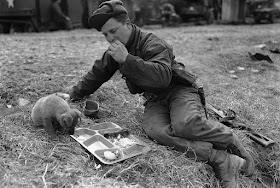 |
| Photo by Gene Herrick, AP |
Friday, November 30, 2018
Dignity Takes a Break
Thursday, November 22, 2018
Dog Gone Dogs!
 |
| Photo by James Martenhoff, AP |
Friday, November 16, 2018
Riflemen at Work
September 1950. Korea. This is a David Douglas Duncan photo. Duncan was embedded with the U.S. Marines during his photo-journalistic foray into the opening months of the Korean War. So while the visual cues are few, it's a safe bet that these are marines (the term "soldier" is specific to U.S. Army troops).
Regardless of their branch of service, the American riflemen cast into Korea encountered the same tactical objectives. The key to victory was control of hills that overlooked the roads. Without control of the high ground, the truck-bound American forces were unable to traverse the Korean countryside. The rifleman's task during the summer of 1950 was not unlike that of Sisyphus; while Sisyphus repeatedly rolled the same rock up the same hill, the riflemen were resigned to taking a hill only to start all over again on the neighboring hill. And the next, and the next.
Duncan's image conveys the exertion and fortitude of fighting men. The man in the foreground wears a rain poncho. Cautious yet deliberate motion is in evidence, displayed not only by the men, but also in the forward lean of the scraggly trees. We do not know the nature of their enemy's entrenchment, but men moving forward probably don't know, either. When such information is lacking, speed and aggressiveness fill the void.
This is how U.S. Army Pvt. Philip Hughes spent the ten weeks he was in Korea, the last summer of his life.
Friday, November 9, 2018
Buddy Sizemore and the Grand Ole Cavalry
 |
| From left; Ashland and Little Jimmie Sizemore; Buddy Sizemore, fresh out of basic; Buddy in Ike jacket with 1st Cav Division shoulder patch. |
That plan did not come to fruition, due to the sudden arrival in North Korea of foot soldiers under the flag of the Chinese People’s Volunteer Army (PVA). The Chinese advanced in numbers that were several orders of magnitude greater than the opposing American and South Korean forces. Using effective tactics already proven by their North Korean allies, the PVA forces stealthily marched cross-country to encircle the road-bound American units. The PVA systematically struck the gaps between U.S. units, attacking battalion and regimental command posts.
Buddy Sizemore was in the midst of this debacle. No setting could be farther removed from the rural music hall circuit travelled by his country and western band. Billed as “Asher and Little Jimmie,” the family act featured Buddy’s father and brother. Other family members were added over time. Buddy played bass fiddle while displaying keen timing as a comedian. Stage acts like this blended a variety of music and comedy, a forerunner to television’s “Hee Haw” program.
There is limited evidence to account for Buddy Sizemore’s fate. The 8th Cavalry was shattered at Unsan, leading to the death or capture of most of its ranks. With unit cohesion shattered, the rifle companies on the line fought until ammunition ran low. Disintegrating into small groups, the Americans had no choice but to retreat as best they could through enemy lines. They had to abandon many of their vehicles and heavy weapons. Roll calls after November 4, 1950 revealed the tremendous loss of personnel. Buddy would not be accounted for until 2006, when his remains were identified among a batch returned from North Korea in 2000. Forensics allowed investigators to ascertain a snippet of Buddy’s fate. His remains were part of a small group exhumed in the vicinity of Hwaong-Ri, a village south of Unsan and near a documented escape route used by elements of the 8th Cav.
Little Jimmie (not to be confused with “Little Jimmy Dickens”) grew up to some renown as a country music personality. The Sizemore Family were among the first Kentuckians nominated to the Grand Ole Opry’s Hall of Fame. At best, Buddy joined the family in spirit to receive the accolades. His remains rest in the East Hill Cemetery of Rushville, Indiana.
Friday, November 2, 2018
Call of the Reservist
1950. Unknown U.S. location. The Korean War erupted as the "wrong war, in the wrong place, at the wrong time," revealing the U.S. military's unpreparedness. After the invasion of South Korea by North Korean forces, the inadequacy of the U.S. Eighth Army's Japan-based occupation forces was quickly revealed. The U.S. Army resorted to a "Plan B" of sorts. Central to this plan was a large roster of reservists - veterans of World War II who maintained reserve status. These men were at home in the U.S., carrying on with the fruits of victory by starting families, building careers, and looking forward to a life of peace and prosperity.
Regardless of their sentiments about being recalled, these men were bound by obligation. With rare exception, they dutifully responded to mobilization orders, usually with little time to get their personal affairs in order. Late 1950 revealed countless scenes like the one above. Here, we see a young sergeant spending a precious few last moments with his wife and son. The setting is possibly an airport, but probably a train or bus station. We have no record of their identities or of the events subsequent to this parting.





